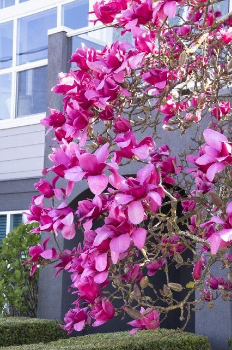Home > Archives > 5th Sept 2022 Edition > Gardening with Gael: Flowering magnolia leaves other trees in the shade Glowing against the background of native bus

MANGAWHAI'S NO.1 NEWSPAPER
|
|
|
Gardening with Gael: Flowering magnolia leaves other trees in the shade Glowing against the background of native bus5 Sept, 2022
Magnolias are ancient species believed to have evolved before bees. The deciduous varieties come from Asia and the evergreen from America. New Zealand, however, is responsible for a number of highly desirable hybrids thanks to the Jury family from Taranaki and Oswald Blumhardt from Northland. My Vulcan was bred by the Jury family, the colour and flower form never failing to impress year after year. The main evergreen variety, Magnolia Grandiflora, is used extensively in parks, along driveways and in larger gardens as a shade tree. The large cream flowers, up to 25cm across, are fragrant. I love the seed heads as well, dark brown and cone shaped the bright red seeds decorate the outside. I was most distressed to read about a line of them being cut down because the roots were interfering with the pavement. I thought maybe the pavement could have been altered to accommodate the trees. These summers we need all the shade we can get. Large shade trees are an important contributor to reducing heat in neighbourhoods. Mark Jury has now created some evergreen magnolias. Upright and evergreen they make great specimens and hedges. Look out for his ‘Fairy’ series. For smaller gardens, the more compact deciduous Magnolia stellata provides a profusion of smaller star-like flowers on bare branches in late winter and early spring. The petals are narrow and elongated hence the ‘star’ shape of the flower. The number of petals vary from eight to ten and on some I’ve counted up to 23. Stellata are closely related to Magnolia Kobus, a native of Japan which grows alongside streams and in spring is smothered in starry white flowers. Most stellata are white. There are now some pink varieties. Magnolia stellata ‘Dawn’ is a vigorous pink variety with very full flowers with lots of petals. I have grown it and it is a lovely variety. Checking up on the new varieties I came across possibly the darkest pink and the ‘frilliest’ flower of any stellata I have seen. The nursery advertising them had them grafted as standards. They look fabulous. There is a double row of long narrow petals although in the photograph I think they appear to be a treble row. Highly desirable. I didn’t look at the price. Magnolias appear to be very expensive this year. Recently I read an article in the New Zealand Gardener which was clearly confusing the author and subsequently confused me as well. One of my favourite plants, known as a Port Wine Magnolia, with the botanical name of Michelia figo has, along with other Michelias, been reclassified as magnolias. Originally it was to do with the position of the flowers on the stem. I notice the change has not happened in the nurseries yet but I am sure it will. Magnolias are very hardy. They require a slightly acid well drained soil. Because wind can damage the blooms, some protection is necessary. Full sun and a little shade are the ideal circumstances for your magnolia to delight year after year.
A flowering Magnolia Vulcan with its distinctive thick magenta petals. PHOTO/DOREEN WYNJA |

 Glowing against the background of native bush, my magnificent Magnolia Vulcan’s magenta blooms feature the cup and saucer shape of one of its parents – Magnolia Campbellii – also known as a Pink Tulip tree.
Glowing against the background of native bush, my magnificent Magnolia Vulcan’s magenta blooms feature the cup and saucer shape of one of its parents – Magnolia Campbellii – also known as a Pink Tulip tree.
